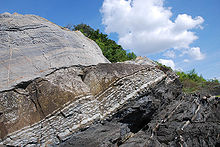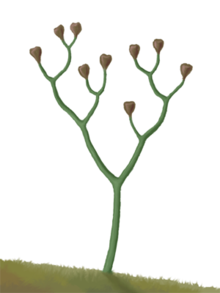Silurian: Difference between revisions
→First terrestrial biota: specifics, with refs. |
|||
| Line 67: | Line 67: | ||
The first fossil records of [[vascular plant]]s, that is, land plants with tissues that carry food, appeared in the second half of the Silurian period. The earliest known representatives of this group are the ''[[Cooksonia]]'' (mostly from the northern hemisphere) and ''[[Baragwanathia]]'' (from Australia). A primitive Silurian land plant with [[xylem]] and [[phloem]] but no differentiation in root, stem or leaf, was much-branched ''[[Psilophyta|Psilophyton]]'', reproducing by [[spore]]s and breathing through [[stomata]] on every surface, and probably [[photosynthesis|photosynthesizing]] in every tissue exposed to light. [[Rhyniophyta]] and primitive [[Lycopodiophyta|lycopod]]s were other land plants that first appear during this period. |
The first fossil records of [[vascular plant]]s, that is, land plants with tissues that carry food, appeared in the second half of the Silurian period. The earliest known representatives of this group are the ''[[Cooksonia]]'' (mostly from the northern hemisphere) and ''[[Baragwanathia]]'' (from Australia). A primitive Silurian land plant with [[xylem]] and [[phloem]] but no differentiation in root, stem or leaf, was much-branched ''[[Psilophyta|Psilophyton]]'', reproducing by [[spore]]s and breathing through [[stomata]] on every surface, and probably [[photosynthesis|photosynthesizing]] in every tissue exposed to light. [[Rhyniophyta]] and primitive [[Lycopodiophyta|lycopod]]s were other land plants that first appear during this period. |
||
Some evidence suggests the presence of predatory [[Trigonotarbida|trigonotarbid arachnoid]]s and [[myriapod]]s in |
Some evidence suggests the presence of predatory [[Trigonotarbida|trigonotarbid arachnoid]]s and [[myriapod]]s in Late Silurian facies. Predatory [[invertebrates]] would indicate that simple [[food web]]s were in place that included non-predatory prey animals. Extrapolating back from [[Early Devonian]] biota, Andrew Jeram ''et al.'' in 1990<ref>Andrew J. Jeram, Paul A. Selden and Dianne Edwards, "Land Animals in the Silurian: Arachnids and Myriapods from Shropshire, England", ''Science'' 2 November 1990:658-61.</ref> suggested a food web based on as yet undiscovered [[detritivore]]s and grazers on microorganisms.<ref>Anna K. Behrensmeyer, John D. Damuth, ''et al.'' ''Terrestrial Ecosystems Through Time'' "Paleozoic Terrestrial Ecosystems" (University of Chicago Press), 1992:209.</ref> |
||
==End Silurian extinction== |
==End Silurian extinction== |
||
Revision as of 01:51, 12 October 2008
Template:Geological period The Silurian is a geologic period and system that extends from the end of the Ordovician period, about 443.7 ± 1.5 Ma (million years ago), to the beginning of the Devonian period, about 416.0 ± 2.8 Ma Template:ICS 2004. As with other geologic periods, the rock beds that define the period's start and end are well identified, but the exact dates are uncertain by 5-10 million years. The base of the Silurian is set at a major extinction event when 60% of marine species were wiped out. See Ordovician-Silurian extinction events.
Historiography
The Silurian system was first identified by Sir Roderick Murchison, who was examining fossil-bearing sedimentary rock strata in south Wales in the early 1830s. He named the sequences for a Celtic tribe of Wales, the Silures, following the convention his friend Adam Sedgwick had established for the Cambrian. In 1835 the two men presented a joint paper, under the title On the Silurian and Cambrian Systems, Exhibiting the Order in which the Older Sedimentary Strata Succeed each other in England and Wales, which was the germ of the modern geological time scale. As it was first identified, the "Silurian" series when traced farther afield quickly came to overlap Sedgwick's "Cambrian" sequence, however, provoking furious disagreements that ended the friendship. Charles Lapworth resolved the conflict by defining a new Ordovician system including the contended beds.
The French geologist Joachim Barrande, building on Murchison's work, used the term Silurian in a more comprehensive sense than was justified by subsequent knowledge. He divided the Silurian rocks of Bohemia into eight stages. His interpretation was questioned in 1854 by Edward Forbes, and the later stages of Barrande, F, G and H, have since been shown to be Devonian. Despite these modifications in the original groupings of the strata, it is recognized that Barrande established Bohemia as a classic ground for the study of the oldest fossils.
Subdivisions
Llandovery
The Llandovery epoch lasted from 443.8 ± 1.5 to 433.4 ± 3.2, and is subdivided into three stages: the Rhuddanian,[1] lasting until 440.8 million years ago, the Aeronian, lasting to 438.5 million years ago, and the Telychian.
Wenlock
The Wenlock, which lasted from 433.4 ± 1.5 to 427.4 ± 3.2, is subdivided into the Sheinwoodian (to 430.5 million years ago) and Homerian ages. It is named after the Wenlock Edge in Shropshire, England. During the Wenlock, the oldest known tracheophytes of the genus Cooksonia, appear. The complexity of slightly younger Gondwana plants like Baragwanathia indicates either a much longer history for vascular plants, perhaps extending into the early Silurian or even Ordovician. See Evolutionary history of plants.
Ludlow
The Ludlow, lasting from 427.4 ± 1.5 to 423 ± 3.2, comprises the Gorstian age, lasting until 425.6 million years ago, and the Ludfordian.
Přídolí
The Pridoli, lasting from 423 ± 1.5 to 419.2 ± 3.2, is the final and shortest epoch of the Silurian.
Regional stages
In North America a different suite of regional stages is sometimes used:
- Cayugan (Late Silurian - Ludlow)
- Lockportian (middle Silurian: late Wenlock)
- Tonawandan (middle Silurian: early Wenlock)
- Ontarian (Early Silurian: late Llandovery)
- Alexandrian (earliest Silurian: early Llandovery)
Silurian paleogeography

During the Silurian, Gondwana continued a slow southward drift to high southern latitudes, but there is evidence that the Silurian icecaps were less extensive than those of the late Ordovician glaciation.The southern continents remained united during this period.The melting of icecaps and glaciers contributed to a rise in sea level, recognizable from the fact that Silurian sediments overlie eroded Ordovician sediments, forming an unconformity. Other cratons and continent fragments drifted together near the equator, starting the formation of a second supercontinent known as Euramerica.

When the proto-Europe collided with North America, the collision folded coastal sediments that had been accumulating since the Cambrian off the east coast of North America and the west coast of Europe. This event is the Caledonian orogeny, a spate of mountain building that stretched from New York State through conjoined Europe and Greenland to Norway. At the end of the Silurian, sea levels dropped again, leaving telltale basins of evaporites in a basin extending from Michigan to West Virginia, and the new mountain ranges were rapidly eroded. The Teays River, flowing into the shallow mid-continental sea, eroded Ordovician strata, leaving traces in the Silurian strata of northern Ohio and Indiana.
The vast ocean of Panthalassa covered most of the northern hemisphere. Other minor oceans include two phases of the Tethys— the Proto-Tethys and Paleo-Tethys— the Rheic Ocean, a seaway of the Iapetus Ocean (now in between Avalonia and Laurentia), and the newly formed Ural Ocean.
Climate
During this period, the Earth entered a long warm greenhouse phase, and warm shallow seas covered much of the equatorial land masses. Early in the Silurian, glaciers retreated back into the South Pole until they almost disappeared in the middle of Silurian. The period witnessed a relative stabilization of the Earth's general climate, ending the previous pattern of erratic climatic fluctuations. Layers of broken shells (called coquina) provide strong evidence of a climate dominated by violent storms generated then as now by warm sea surfaces. Later in the Silurian, the climate cooled slightly, but in the Silurian-Devonian boundary, the climate became warmer.
Silurian aquatic biota

Silurian high sea levels and warm shallow continental seas provided a hospitable environment for marine life of all kinds. Silurian beds are oil and gas producers in some areas. Extensive beds of Silurian hematite -- an iron ore -- in eastern North America were important to the early American colonial economy.
Coral reefs made their first appearance during this time, built by extinct tabulate and rugose corals. The first bony fish, the Osteichthyes appeared, represented by the Acanthodians covered with bony scales; fishes reached considerable diversity and developed movable jaws, adapted from the supports of the front two or three gill arches. A diverse fauna of Eurypterids (Sea Scorpions) -- some of them several meters in length -- prowled the shallow Silurian seas of North America; many of their fossils have been found in New York State. Leeches also made their appearance during the Silurian Period. Brachiopods, bryozoa, molluscs, and trilobites were abundant and diverse.
First terrestrial biota

The Silurian was the first period to see macrofossils of extensive terrestrial biota, in the form of moss forests along lakes and streams.
The first fossil records of vascular plants, that is, land plants with tissues that carry food, appeared in the second half of the Silurian period. The earliest known representatives of this group are the Cooksonia (mostly from the northern hemisphere) and Baragwanathia (from Australia). A primitive Silurian land plant with xylem and phloem but no differentiation in root, stem or leaf, was much-branched Psilophyton, reproducing by spores and breathing through stomata on every surface, and probably photosynthesizing in every tissue exposed to light. Rhyniophyta and primitive lycopods were other land plants that first appear during this period.
Some evidence suggests the presence of predatory trigonotarbid arachnoids and myriapods in Late Silurian facies. Predatory invertebrates would indicate that simple food webs were in place that included non-predatory prey animals. Extrapolating back from Early Devonian biota, Andrew Jeram et al. in 1990[2] suggested a food web based on as yet undiscovered detritivores and grazers on microorganisms.[3]
End Silurian extinction

At the end of Silurian, a series of minor extinction events, including the Lau event, occurred. They were probably caused by climate change or impact events.[citation needed]
This section needs expansion. You can help by adding to it. (June 2008) |
Notes
- ^ Named for the Cefn-Rhuddan Farm in the Llandovery area; confusingly, Rhuddlan lies on Silurian strata as well..
- ^ Andrew J. Jeram, Paul A. Selden and Dianne Edwards, "Land Animals in the Silurian: Arachnids and Myriapods from Shropshire, England", Science 2 November 1990:658-61.
- ^ Anna K. Behrensmeyer, John D. Damuth, et al. Terrestrial Ecosystems Through Time "Paleozoic Terrestrial Ecosystems" (University of Chicago Press), 1992:209.
References
- Emiliani, Cesare. (1992). Planet Earth : Cosmology, Geology, & the Evolution of Life & the Environment. Cambridge University Press. (Paperback Edition ISBN 0-521-40949-7)
- Mikulic, DG, DEG Briggs, and J Kluessendorf. 1985. A new exceptionally preserved biota from the Lower Silurian of Wisconsin, USA. Philosophical Transactions of the Royal Society of London, 311B:75-86.
- Moore, RA, DEG Briggs, SJ Braddy, LI Anderson, DG Mikulic, and J Kluessendorf. 2005. A new synziphosurine (Chelicerata: Xiphosura) from the Late Llandovery (Silurian) Waukesha Lagerstatte, Wisconsin, USA. Journal of Paleontology:79(2), pp. 242-250.
- Ogg, Jim; June, 2004, Overview of Global Boundary Stratotype Sections and Points (GSSP's) http://www.stratigraphy.org/gssp.htm Accessed April 30, 2006.
External links
- Paleos: Silurian
- UCMP Berkeley: The Silurian
- Paleoportal: Silurian strata in U.S., state by state
- USGS:Silurian and Devonian Rocks (U.S.)
- "International Commission on Stratigraphy (ICS)". Geologic Time Scale 2004.
{{cite web}}: Unknown parameter|accessmonthday=ignored (help); Unknown parameter|accessyear=ignored (|access-date=suggested) (help) - Examples of Silurian Fossils
